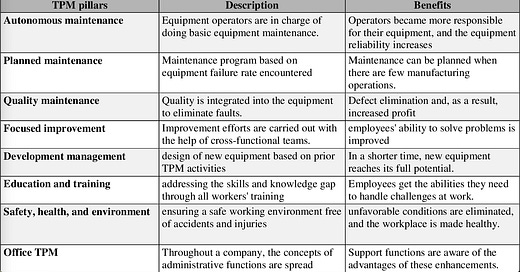Hello.
Munavver here.
Today, let’s talk about Total Productive Maintenance.
What’s TPM?
Total Productive Maintenance (TPM) is a comprehensive approach to equipment maintenance and management that aims to maximize the operational efficiency and effectiveness of manufacturing equipment.
TPM originated in Japan and is often associated with the principles of Lean Manufacturing. The goal of TPM is to minimize equipment downtime, reduce defects, and improve overall equipment effectiveness (OEE).
TPM is achieved through a structured framework consisting of eight fundamental pillars:
1. Autonomous Maintenance (Jishu Hozen):
In this pillar, operators take responsibility for the routine cleaning, inspection, and minor maintenance of their equipment. The objective is to prevent equipment deterioration, reduce breakdowns, and create a sense of ownership among operators for the machines they use.
2. Planned Maintenance (Kobetsu Kaizen):
Planned maintenance involves scheduled, periodic equipment inspections, servicing, and more significant repairs that cannot be handled through autonomous maintenance. The goal is to identify and address potential issues before they lead to unexpected breakdowns.
3. Quality Maintenance (Hinshitsu Hozen):
Quality maintenance focuses on preventing equipment-related defects. It aims to ensure that equipment is capable of producing products within specified quality parameters. Maintaining equipment in a state of optimal condition helps reduce product defects.
4. Training and Education (Kenshu):
Well-trained employees are crucial for effective TPM. This pillar emphasizes the importance of ongoing training and education for employees to ensure they have the necessary skills to operate, maintain, and troubleshoot equipment.
5. Early Equipment Management (Kikotei Kosaku):
This pillar focuses on the process of introducing new equipment or making significant modifications to existing machinery. The goal is to ensure that new equipment is reliable, efficient, and easy to maintain.
6. Process and Equipment Improvement (Kobetsu Kaizen):
This pillar promotes continuous improvement in equipment and processes. It encourages cross-functional teams to identify and eliminate inefficiencies, bottlenecks, and sources of waste in equipment and processes.
7. Administrative and Office TPM (Kacho Hozen):
While TPM is often associated with manufacturing equipment, this pillar extends TPM principles to administrative and office processes. It aims to improve the efficiency and reliability of office operations and reduce errors.
8. Safety, Health, and Environment (Anzen Kanketsu):
TPM places a strong emphasis on safety, health, and environmental concerns. It seeks to create a safe and healthy work environment while minimizing the environmental impact of equipment and processes.
Implementing TPM and adhering to these eight pillars can result in various benefits, including increased equipment reliability, reduced downtime, improved product quality, higher employee engagement, and ultimately greater competitiveness in the market.
TPM is a holistic approach to equipment and process management that aligns with Lean principles and can contribute to overall operational excellence.
Here is a brief outline of TPM and its benefits.
Image Credits: The Strategy of Successful Total Productive Maintenance (TPM): Implementation and Benefits of TPM (Literature Review)
If you need more clarity on this or want to implement this concept in your organization, then get in touch today.
Best,
Munavver Fairooze (Connect with me on Linkedin)
what’s the most money-leaking problem you are facing at your company? Do let me know.




